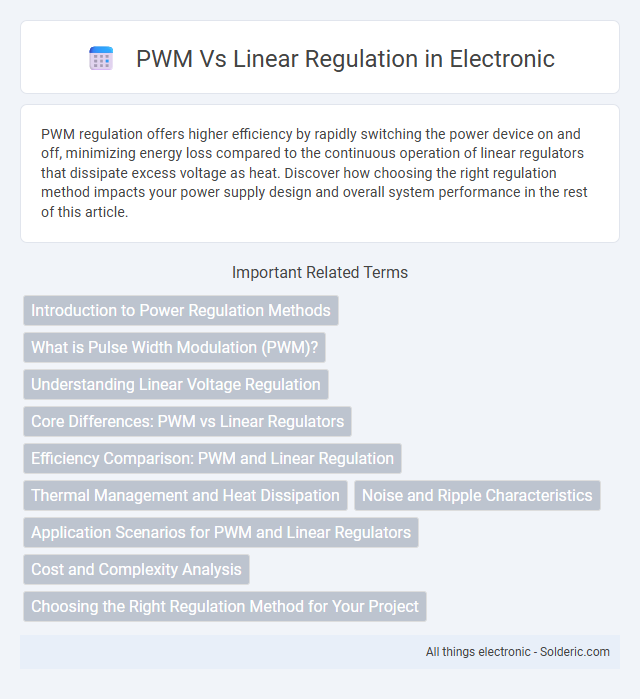PWM regulation offers higher efficiency by rapidly switching the power device on and off, minimizing energy loss compared to the continuous operation of linear regulators that dissipate excess voltage as heat. Discover how choosing the right regulation method impacts your power supply design and overall system performance in the rest of this article.
Comparison Table
| Feature | PWM Regulation | Linear Regulation |
|---|---|---|
| Operation | Switching regulator using pulse width modulation | Continuous voltage drop across a transistor |
| Efficiency | High (typically 80-95%) | Low to moderate (30-60%) |
| Heat Dissipation | Low heat generation | High heat generation requiring heatsinks |
| Output Noise | Higher ripple and noise, needs filtering | Low noise and ripple, clean output |
| Complexity | More complex circuit design | Simple circuit, easy to implement |
| Cost | Generally higher due to components | Lower cost, fewer components |
| Size | Smaller overall size due to less heat sinking | Larger size due to heat sinks |
| Applications | Power supplies, battery charging, efficient voltage regulation | Low noise analog circuits, audio equipment, sensitive electronics |
Introduction to Power Regulation Methods
Power regulation methods are essential for controlling voltage and current in electronic devices. Pulse Width Modulation (PWM) regulates power by rapidly switching the output between on and off states, offering high efficiency and reduced heat dissipation. In contrast, linear regulation maintains voltage through continuous control of a series pass transistor, providing low noise and simplicity but with lower energy efficiency due to constant power dissipation.
What is Pulse Width Modulation (PWM)?
Pulse Width Modulation (PWM) is a technique used to control the amount of power delivered to an electrical load by varying the duty cycle of a digital signal. This method switches the power supply on and off at a high frequency, adjusting the ratio of "on" time to "off" time to regulate voltage and current efficiently. PWM is widely used in applications such as motor speed control, LED dimming, and power regulation due to its high efficiency and minimal heat generation compared to linear regulators.
Understanding Linear Voltage Regulation
Linear voltage regulation maintains a constant output voltage by dissipating excess power as heat through a variable resistance, ensuring minimal voltage ripple and noise. This method is ideal for low-noise applications but often results in lower efficiency, especially when input voltage is significantly higher than the output. Linear regulators are preferred for sensitive analog circuits due to their simplicity and clean output voltage characteristics.
Core Differences: PWM vs Linear Regulators
PWM regulators use high-frequency switching to efficiently convert voltage by rapidly turning the power device on and off, minimizing energy loss and heat generation. Linear regulators maintain a constant output voltage by dissipating excess power as heat, resulting in simpler design but lower efficiency, especially under high voltage differentials. The core difference lies in PWM's switching mode for improved efficiency versus the linear regulator's continuous conduction for simplicity and lower noise.
Efficiency Comparison: PWM and Linear Regulation
PWM regulators achieve higher efficiency by rapidly switching the output transistor on and off, minimizing power loss as heat, often reaching efficiencies above 85-90%. Linear regulators dissipate excess voltage as heat through a continuously active pass element, typically resulting in efficiencies below 50%, especially when input-output voltage difference is large. For power-sensitive applications, PWM regulators are preferred due to their superior energy efficiency and reduced thermal management requirements.
Thermal Management and Heat Dissipation
PWM regulators excel in thermal management by rapidly switching the power transistor on and off, minimizing power loss and heat generation compared to linear regulators. Linear regulation dissipates excess voltage as heat, requiring large heat sinks to manage thermal buildup, which can limit efficiency and increase system size. Your choice of PWM ensures improved heat dissipation and cooler operation, enhancing overall system reliability and performance.
Noise and Ripple Characteristics
PWM (Pulse Width Modulation) regulators exhibit higher noise and ripple due to their switching nature, typically generating electromagnetic interference (EMI) and voltage fluctuations around the switching frequency. Linear regulators provide a cleaner output with minimal noise and ripple, as they continuously dissipate excess voltage as heat without switching elements. The choice between PWM and linear regulation depends on the application's noise sensitivity and efficiency requirements, with linear regulators favored for low-noise environments.
Application Scenarios for PWM and Linear Regulators
PWM regulators excel in applications requiring high efficiency and heat dissipation management, such as power supplies for computers, LED dimming, and motor controls. Linear regulators are preferred in low-noise environments like audio equipment, precision measurement devices, and low-power sensor circuits where simplicity and minimal electromagnetic interference are crucial. Your choice depends on efficiency needs, thermal constraints, and the sensitivity of the electronic components involved.
Cost and Complexity Analysis
PWM regulators typically offer lower power dissipation and higher efficiency, which translates to reduced heat management costs and compact designs, making them more cost-effective in high-power applications. Linear regulators have simpler circuitry with fewer external components, resulting in lower initial design complexity and cost for low-power or noise-sensitive applications. The trade-off between PWM's design complexity and component cost versus linear regulator's inefficiency must be evaluated based on the specific power and performance requirements.
Choosing the Right Regulation Method for Your Project
Choosing the right regulation method for your project depends on efficiency, heat dissipation, and complexity requirements. PWM (Pulse Width Modulation) regulators offer higher efficiency and lower heat generation, making them ideal for power-sensitive applications. Linear regulation provides simpler design and cleaner outputs but results in greater power loss and heat, suitable for low-power or noise-sensitive projects.
PWM vs Linear Regulation Infographic

 solderic.com
solderic.com